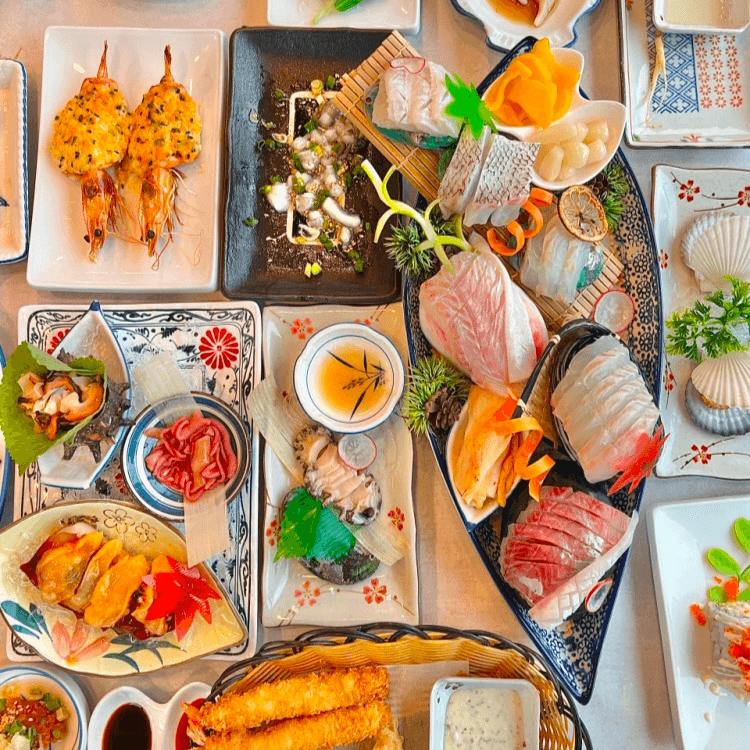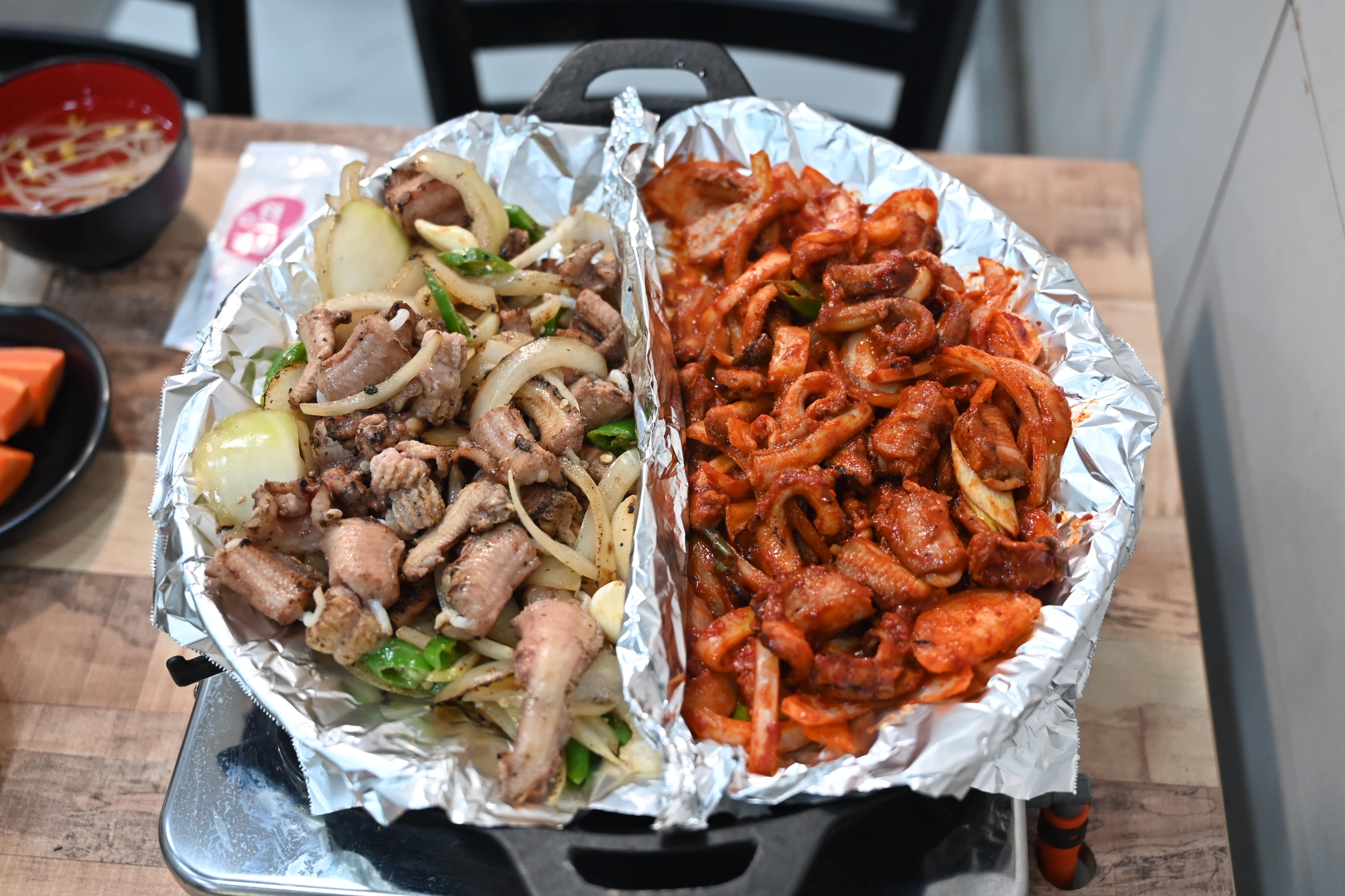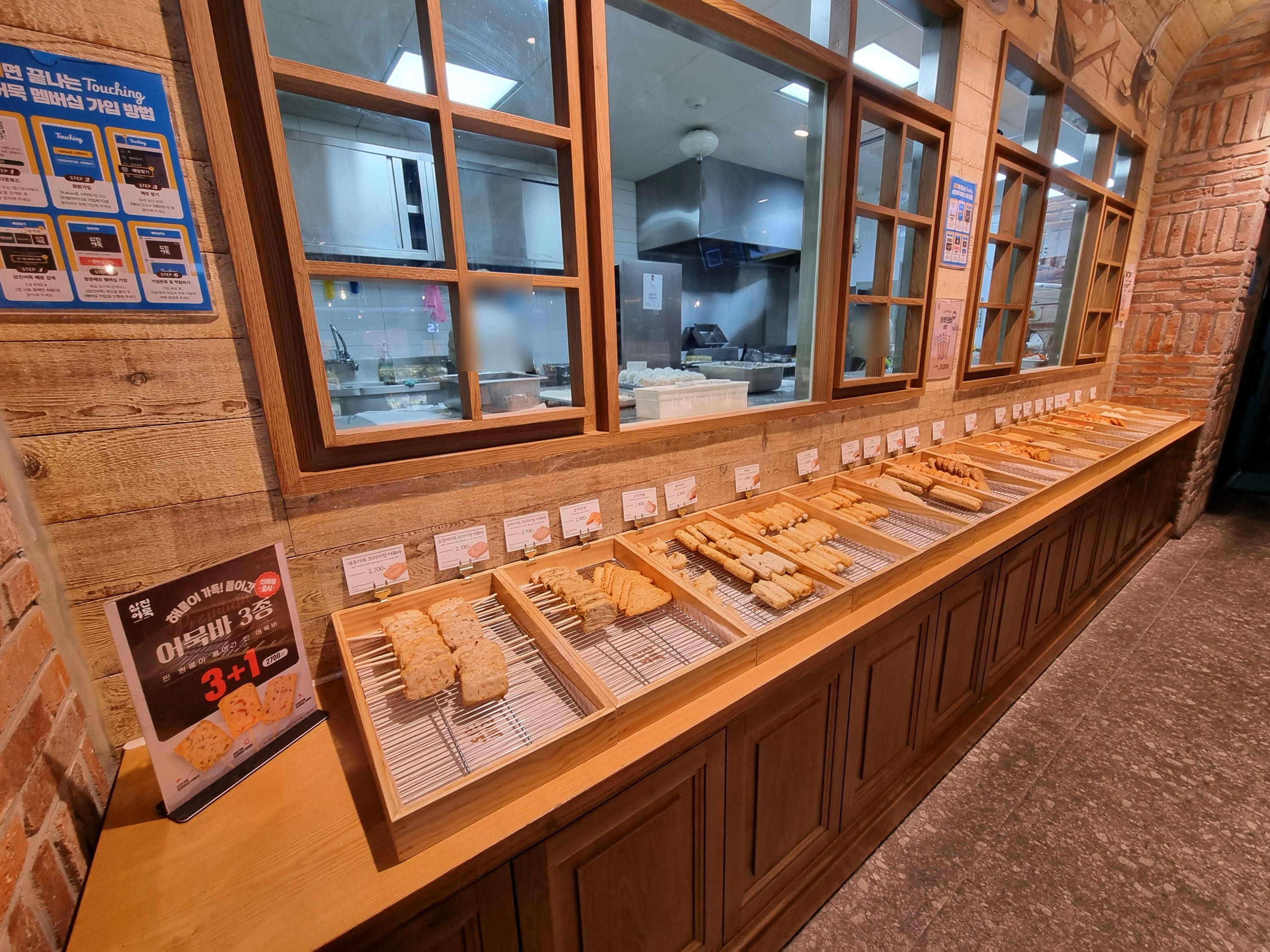ร้านอาหารที่ดีที่สุดในปูซาน: กินอะไรและที่ไหน
6 สิ่งที่ควรกินในปูซาน และสถานที่ที่ควรไป
สรุป
ปูซานเป็นเมืองในเกาหลีใต้ที่มีชื่อเสียงด้านวัฒนธรรมอันหลากหลาย ชายหาดที่สวยงาม และอาหารรสเลิศ อาหารของเมืองนี้เป็นการผสมผสานระหว่างอาหารเกาหลีแบบดั้งเดิมและอาหารทะเลพิเศษที่มีเอกลักษณ์เฉพาะตัว ซึ่งผู้ที่ชื่นชอบอาหารทุกคนต้องลองชิม ในคู่มือนี้ เราจะสำรวจร้านอาหารที่ดีที่สุดบางแห่งของปูซานและสถานที่ที่หาซื้ออาหารเหล่านี้ได้
ดเวจี กุกบับ (ซุปหมูกับข้าว)
คุณไม่สามารถไปปูซานได้หากไม่ได้ลองกิน dwaeji gukbap ซึ่งเป็นซุปหมูกับข้าว ซึ่งเป็นอาหารที่มีชื่อเสียงที่สุดอย่างหนึ่งของปูซาน อาหารจานนี้ทำง่าย ๆ โดยต้มกระดูกหมูเป็นเวลานานจนซุปกลายเป็นสีขาวและครีม ซุปมีเนื้อครีมและมัน แต่ไม่มากเกินไป ทำให้เหมาะสำหรับมื้ออาหารที่หนักท้อง เมื่อเสิร์ฟ คุณจะได้รับข้าวหนึ่งถ้วย และโดยทั่วไปแล้ว ผู้คนจะกินโดยผสมข้าวที่หุงสุกแล้วกับซุป คุณสามารถปรุงรสซุปตามความชอบส่วนตัวได้ และยังมีเครื่องเคียงทั่วไปที่ผู้คนมักจะใส่ลงไปด้วย เช่นซาวจอต(กุ้งเค็ม),บุชมูชิม(กระเทียมต้นหอมปรุงรส) หรือกาดักดูกีหัวไชเท้าหั่นเต๋ากิมจิ-

คุณจะพบ dwaeji gukbap ที่ดีที่สุดบางส่วนในปูซานได้ที่:
ยองจิน ดเวจี กุกบับ-แผนที่ Naver-แผนที่กูเกิ้ล-
เมื่อพูดถึง Dwaeji Gukbap ในปูซาน Yeongjin Dwaeji Gukbap (영진돼지국밥) เป็นชื่อที่มักจะถูกเอ่ยถึงอยู่เสมอ ร้านนี้มีสาขาหลายแห่งทั่วปูซาน แต่สาขาหลักที่คนส่วนใหญ่มักไปคือสาขาที่ Saha-gu ร้านมีชื่อเสียงในเรื่องซุปครีมที่เสิร์ฟมาในปริมาณมาก นอกจากซุปแล้ว _Suyuk_ (หมูต้ม) ยังเป็นเมนูโปรดของใครหลายๆ คนอีกด้วย ซุปมีราคาชิ้นละ 9,000 วอน
**เวลาเปิดทำการ:**09.30-21.30น. พัก 15.00-17.00น.
ซับยอน ชอกโก ดเวจี กุกบับ-แผนที่ Naver-แผนที่กูเกิ้ล-
Subyeon Choego Dwaeji Gukbap (수변최고돼지국밥) เป็นหนึ่งในร้านอาหาร Dwaeji Gukbap ที่ได้รับความนิยมมากที่สุดในปูซาน ร้านนี้มีสาขาทั้งหมด 4 แห่งทั่วปูซาน โดยสาขาหลักอยู่ที่ซูยองกูซึ่งเปิดตลอด 24 ชั่วโมง ร้านนี้เสิร์ฟซุปหลากหลายชนิดให้คุณเลือก ไม่ว่าจะเป็นซุปเนื้อ ซุปหมู หรือซุปใสซุนแด(ไส้กรอกเลือด) หรือแบบผสมกันก็ได้ ราคาซุปทั้งหมด 9,000 วอน
**เวลาเปิดทำการ :**24 ชั่วโมง
กึกดง ดเวจี กุกบับ-แผนที่ Naver-แผนที่กูเกิ้ล-
หากคุณกำลังมองหาร้าน Dwaeji Gukbap ใกล้ Haeundae ร้าน Geukdong Dwaeji Gukbap เป็นหนึ่งในตัวเลือกยอดนิยมที่สุด คิวยาวมาก และร้านก็แน่นเกือบตลอดเวลา อย่างไรก็ตาม โปรดทราบว่าเมื่อเทียบกับซุปครีมทั่วไปของร้าน Dwaeji Gukbap แล้ว ซุปของร้านนี้จะมีน้ำซุปใสและเบากว่ามาก และรสชาติของหมูก็ไม่เข้มข้นนัก นอกจากนี้ เนื้อสัตว์ของร้านนี้ยังหั่นเป็นชิ้นเล็กๆ กว่าร้าน Dwaeji Gukbap ทั่วไปอีกด้วย ดังนั้น หากคุณกำลังมองหาอะไรเบาๆ หลังจากออกไปเที่ยวกลางคืนที่ Haeundae ร้านนี้อาจเป็นตัวเลือกที่ดี แต่แน่นอนว่า หากคุณกำลังมองหาอะไรที่มีรสชาติมากกว่านี้ คุณอาจต้องพิจารณาตัวเลือกอื่นๆ ราคาก็แพงกว่าเล็กน้อยที่ 10,000 วอน
**เวลาเปิดทำการ:**ทุกวัน เวลา 08.00 - 21.00 น. พักเบรก 15.30 - 17.00 น. วันจันทร์ - พฤหัสบดี สั่งอาหารรอบสุดท้าย 20.30 น.
มิลมยอน (บะหมี่ข้าวสาลี)
หากคุณเคยได้ยินเกี่ยวกับอาหารเกาหลีแนงมยอน-มิลมยอนเป็นอาหารประเภทเส้นที่ทำจากเส้นข้าวสาลี ฤดูร้อนในปูซานนั้นค่อนข้างร้อนมาก และมิลมยอนถือเป็นอาหารที่เหมาะสำหรับทานเพื่อคลายร้อน โดยปกติมิลมยอนจะเสิร์ฟในสองลักษณะ คือมุลมิลมยอนโดยที่เส้นจะเสิร์ฟมาในน้ำซุปเย็นชื่นใจ หรือบิบิมมิลมยอนโดยที่เส้นบะหมี่ผัดกับซอสเผ็ด (ลองนึกถึงบิบิมบับ แต่เปลี่ยนข้าวเป็นมิลมยอนแทน) *มุลมิลมยอน *โดยทั่วไปแล้วถือว่ามีรสชาติที่ค่อนข้างซับซ้อน ดังนั้นหากคุณกำลังมองหาอะไรที่ปลอดภัยกว่านั้น ลองพิจารณาเลือกมุลมิลมยอนบิบิมมิลมยอนแต่ถ้าคุณอยากลองอะไรใหม่ๆ และมาเที่ยวปูซานในฤดูร้อน เราขอแนะนำอย่างยิ่งให้คุณลอง *มุลมิลมยอน *อย่าลืมเติมน้ำส้มสายชูและมัสตาร์ด (ที่ร้านอาหารจัดเตรียมไว้ให้) ลงในอาหารของคุณด้วยมุลมิลมยอนเพื่อเพิ่มรสชาติที่เข้มข้นยิ่งขึ้น

หากต้องการมิลมยอนที่ดีที่สุดบางแห่งในปูซาน โปรดดู:
กุกแจ มิลมยอน-แผนที่ Naver-แผนที่กูเกิ้ล-
ร้านกุกแจมิลมยอนเป็นที่รู้จักในฐานะหนึ่งใน 3 ร้านมิลมยอนที่ดีที่สุดในปูซาน ร้านนี้เป็นร้านอาหารเฉพาะทางที่มีเมนูให้เลือกเพียง 2 รายการ คือ มุลมิลมยอนและบิบิมมิลมยอน โดยมีให้เลือกทั้งแบบขนาดเล็ก (9,000 วอน) หรือขนาดใหญ่ (10,000 วอน) เหตุผลสำคัญประการหนึ่งที่ทำให้ร้านนี้ได้รับความนิยมก็คือเส้นบะหมี่ที่เหนียวนุ่มและแน่น น้ำซุปของมุลมิลมยอนอาจจืดชืดสำหรับบางคน แต่ด้วยน้ำส้มสายชูและมัสตาร์ดก็ช่วยได้ไม่น้อย
**เวลาเปิดทำการ:**10.00-20.00 น. ทุกวัน
แฮอุนแด กายา มิลมยอน-แผนที่ Naver-แผนที่กูเกิ้ล-
มีวิธีใดที่ดีกว่าที่จะคลายร้อนหลังจากเที่ยวชายหาดมาทั้งวันไปกว่าการดื่มมิลมยอนสักถ้วย ร้าน Haeundae Gaya Milmyeon เป็นหนึ่งในร้านอาหารยอดนิยมใกล้ชายหาด Haeundae เตรียมตัวรอคิวได้เลย แม้ว่าผู้คนจะออกไปค่อนข้างเร็วก็ตาม ร้านนี้มีเพียงสามรายการในเมนู:มิลมยอน(9,000วอน)บิบิมมยอน(9,000วอน) และมานดู(5,000วอน)
**เวลาเปิดทำการ:**10.00-21.00 น. ทุกวัน
โชรยัง มิลมยอน-แผนที่ Naver-แผนที่กูเกิ้ล-
Choryang Milmyeon เป็นอีกร้านอาหารที่ติดอันดับหนึ่งในสามร้านที่ดีที่สุดในปูซาน ในขณะที่มุลมิลมยอนได้รับการวิจารณ์ทั้งดีและไม่ดีบิบิมมิลมยอนได้รับการตอบรับเป็นอย่างดีโดยทั่วไป ราคาที่ร้าน Choryang Milmyeon ก็ค่อนข้างถูกกว่า โดยคุณสามารถสั่งจานเล็กได้ในราคา 6,000 วอนและจานใหญ่ในราคา 6,500 วอน นอกจากนี้ยังมีมานดูและ _Seafood Kalguksu _ (บะหมี่ทะเล) อยู่ในเมนู ซึ่งทั้งสองอย่างก็คุ้มค่าที่จะลองชิมเมื่อคุณไปที่นั่น
**เวลาเปิดทำการ:**10.00-22.00 น. ทุกวัน
แซงซอนฮเว (ปลาดิบหั่นบาง)
เมื่อเราคิดถึงปลาดิบแล่ สิ่งที่มักจะนึกถึงคือซาซิมิสดของญี่ปุ่น แต่คุณรู้หรือไม่ว่าเกาหลีก็ทำปลาดิบแล่ได้ดีมากเช่นกัน หากคุณอยู่ที่ปูซานโดยเฉพาะ อย่าลืมลองชิมปลาดิบแล่ของที่นี่ เนื่องจากปูซานเป็นเมืองท่า อาหารทะเลในปูซานจึงสดมากและราคาไม่แพงแซงซอนฮเว(หรือปลาดิบหั่นเป็นชิ้น) จะต้องปรุงสดตามคำสั่งซื้อ จึงทำให้มีรสชาติหวานและเคี้ยวหนึบ มักมีคำแนะนำให้หลีกเลี่ยงการรับประทานอาหารทะเลดิบในช่วงฤดูร้อน เนื่องจากความร้อนอาจทำให้ปลาดิบเสียได้อย่างรวดเร็ว แต่ตราบใดที่คุณไม่ทิ้งปลาไว้ข้างนอกนานเกินไปก่อนรับประทาน คุณก็จะไม่มีปัญหาอะไร

สถานที่บางแห่งที่คุณสามารถไปทานปลาดิบหั่นบาง ๆ ได้ ได้แก่:
ศูนย์มิลลักโฮ-แผนที่ Naver-แผนที่กูเกิ้ล-
สำหรับสิ่งที่สดใหม่ที่สุดแซงซอนฮเวอย่าลืมไปที่ Millak Hoe Centre ซึ่งเป็นตลาดอาหารทะเลที่ตั้งอยู่บนชายหาด Gwangalli ที่ร้านอาหารใน Millak Hoe Centre คุณจะสามารถเลือกปลาได้เอง และร้านอาหารจะเตรียมปลาให้คุณทันที ที่ Millak Hoe Centre คุณสามารถมั่นใจได้ว่าปลาจะสด แต่อย่าคาดหวังว่าจะได้รับบริการที่ยอดเยี่ยมหรือบรรยากาศการรับประทานอาหารที่สะดวกสบาย!
**เวลาเปิดทำการ:**แตกต่างกันไปตามแต่ละร้านค้า
กวางอัน ดาชี-แผนที่ Naver-แผนที่กูเกิ้ล-
ร้านอาหารทะเลอีกแห่งที่ตั้งอยู่ใกล้ชายหาดควางอัลลี ร้าน GwangAn Dachi (광안다찌) เป็นหนึ่งในร้านอาหารทะเลที่ได้รับคะแนนสูงสุดในพื้นที่ ไม่เพียงแต่จะสดและอร่อยเท่านั้น คุณยังจะได้เห็นวิวสะพานควางอันที่สวยงามพร้อมกับบริการที่ยอดเยี่ยมอีกด้วย เนื่องจากร้านนี้อยู่ห่างจากศูนย์การค้า Millak Hoe ที่พลุกพล่าน คุณจึงได้สัมผัสกับบรรยากาศที่เงียบสงบกว่าที่ร้านอาหารแห่งนี้ เซ็ตอาหารสำหรับ 1 คนมีราคา 49,000 วอน ซึ่งถูกกว่าร้านอาหารอื่นๆ ส่วนใหญ่ในพื้นที่เดียวกัน
โปรดทราบว่าหากคุณต้องการรับประทานอาหารที่ GwangAn Dachi จำเป็นต้องจองโต๊ะ คุณจะต้องมีหมายเลขโทรศัพท์ของเกาหลีเพื่อทำการจองล่วงหน้าการจองแต่บางทีคุณอาจลองส่ง DM ของพวกเขาได้อินสตาแกรมเพื่อดูว่าเขารับจองทางอินสตาแกรมด้วยไหม
**เวลาเปิดทำการ:**ทุกวัน เวลา 12.00 - 23.00 น. พักเบรก 15.00 - 16.30 น. สั่งอาหารรอบสุดท้าย 20.30 น.
โกมจังกอกี (ปลาไหลย่าง)
กอมจังกอกีเป็นอาหารทะเลอีกชนิดหนึ่งที่ได้รับความนิยมในปูซาน โดยทำมาจากปลาไหลน้ำจืดที่หมักในซอสรสเผ็ดและหวานเล็กน้อย จากนั้นจึงย่างปลาไหลบนเตาไฟจนเนื้อปลานุ่มกรอบด้านนอก แต่เนื้อปลาด้านในยังนุ่มและชุ่มฉ่ำ ขึ้นอยู่กับความชอบของแต่ละคน โดยสามารถทานคู่กับเกลือหรือยางนยอม(ซอสเผ็ด).

คยองบุกซาน กอมจังกอ-แผนที่ Naver-แผนที่กูเกิ้ล-
ร้านอาหาร Gyeongbuksan ggomjangeo (경북산꼼장어) เป็นร้านอาหารเล็กๆ บรรยากาศอบอุ่นในย่าน Choryang เมืองปูซาน ปลาไหลชิ้นเล็กๆ ราคา 45,000 วอน และหากคุณต้องการลองทั้งรสชาติเค็มและเค็มยางนยอมรสชาติ มีให้เลือกแบบครึ่งจานในราคา 65,000 วอน ส่วนแบบครึ่งจานเหมาะสำหรับ 3-4 ท่าน ปลาไหลของร้านนี้ขึ้นชื่อเรื่องรสชาติที่ปรุงรสมาอย่างดีและไม่มีรสคาว หากต้องการประสบการณ์ที่ดีที่สุด ควรสั่งข้าวผัด (ราคา 2,500 วอน) ในตอนท้ายมื้ออาหาร
**เวลาเปิดทำการ:**13.00-00.30 น. วันจันทร์-พฤหัสบดี 11.00-01.30 น. วันศุกร์-อาทิตย์
กีจังจองกาจิบ กอมจังกอ-แผนที่ Naver-แผนที่กูเกิ้ล-
นี่เป็นร้านอาหารปลาไหลย่างยอดนิยมอีกร้านหนึ่ง มีชื่อเสียงในเรื่องอาหารสดอร่อยและบริการดีเยี่ยม โดยขึ้นชื่อในเรื่องปลาไหลย่างเกลือในราคา 30,000 วอนต่อท่าน นอกจากนี้ยังมีเซ็ตเมนูที่ประกอบด้วยซัมกยอบซัล(หมูสามชั้น) รวมกับยางนยอมปลาไหลย่าง
**เวลาเปิดทำการ:**ทุกวัน 11.00 - 21.30 น. พักเบรก 15.30 - 16.00 น. สั่งอาหารรอบสุดท้าย 20.30 น.
ดงแนพาจอน (แพนเค้กต้นหอม)
ผู้ที่คุ้นเคยกับอาหารเกาหลีน่าจะรู้แล้วพาจอน(แพนเค้ก) แต่บางส่วนที่พบได้บ่อยที่สุดพาจอนที่คุณอาจจะได้ลองก็คือกิมจิจอน(แพนเค้กกิมจิ)หรือแฮมึลจอน(อาหารทะเล) หากคุณอยู่ที่ปูซาน ให้ลืมเรื่องนั้นไปและไปกินอาหารทะเลดงแน ปาจอน(แพนเค้กต้นหอม) นำแป้งข้าวเจ้ามาผสมกับต้นหอม อาหารทะเลสด เนื้อวัว และกุ้ยช่าย แล้วนำไปทอดในกระทะจนกรอบและมีกลิ่นหอม แพนเค้กเนื้อนุ่มอร่อยที่สุดเมื่อรับประทานคู่กับพริกแดงผสมน้ำส้มสายชู

คุณสามารถพบ Pajeon ได้ง่ายๆ ตามท้องถนนหรือในร้านอาหารเกาหลีหลายๆ แห่ง แต่ต่อไปนี้คือร้านอาหารบางร้านที่ขึ้นชื่อในเรื่อง Pajeon มากที่สุด
ดงแน ฮัลแม พาจอน-แผนที่ Naver-แผนที่กูเกิ้ล-
นี่คือหนึ่งในร้านอาหารที่ขึ้นชื่อในเรื่องดงแนพาจอนแบบดั้งเดิม มีราคาค่อนข้างแพง โดยจานเล็กดงแนพาจอนราคา 22,000 วอน และจานปกติราคา 30,000 วอน แต่หลายคนบอกว่าจานนี้เป็นจานที่ดีที่สุดที่เคยลองมา บรรยากาศภายในร้านยังให้ความรู้สึกแบบดั้งเดิมและอบอุ่น ทำให้ประสบการณ์การรับประทานอาหารเป็นที่น่าพอใจมาก ขอแนะนำให้ลองชิมดูมักกอลลี(ไวน์ข้าวเกาหลี) และกอลแบงกี-มูชิม(ยำหอยจันทร์)ทานคู่กับพาจอนค่ะ
**เวลาเปิดทำการ:**วันพุธ-อาทิตย์ เวลา 12.00-21.00 น. พักเบรก 15.30-17.00 น. ปิดวันจันทร์-อังคาร
ซอมุนนัน ดงแน พาจอน-แผนที่ Naver-แผนที่กูเกิ้ล-
ร้าน Somunnan Dongnae Pajeon ตั้งอยู่ใกล้ทางเข้าอุทยาน Geumgang และเป็นตัวเลือกที่ดีสำหรับผู้ที่ต้องการทานของว่างก่อน (หรือหลัง) เดินป่า ถึงแม้ว่าทางร้านจะมีเมนูอื่นๆ ให้เลือก แต่เมนูที่ขึ้นชื่อที่สุดคือ pajeon ซึ่งค่อนข้างชื้นแต่มีรสชาติและอร่อยมาก สำหรับผู้ที่ชื่นชอบรสชาติของต้นหอม คุณจะต้องดีใจเมื่อรู้ว่ารสชาติของต้นหอมในแพนเค้กนั้นค่อนข้างเข้มข้น pajeon ของร้านนี้มีราคา 15,000 วอน ซึ่งถือว่าแพง แต่ปริมาณนั้นก็เยอะมากและทานได้สองคน
**เวลาเปิดทำการ:**ทุกวัน เวลา 10.00 - 22.00 น. ปิดทุกวันจันทร์แรกและสามของเดือน
เค้กปลาสไตล์ปูซาน
เมืองปูซานขึ้นชื่อเรื่องเค้กปลา โดยเค้กปลามีเนื้อปลาอยู่เป็นจำนวนมาก ทำให้เค้กปลามีเนื้อเหนียวนุ่มและรสชาติอร่อยเป็นพิเศษ มีวิธีรับประทานเค้กปลาสไตล์ปูซานหลายวิธี โดยวิธีที่นิยมรับประทานมากที่สุดคือออมุกซึ่งเป็นอาหารข้างทางยอดนิยมทั่วทั้งเกาหลีใต้ และโดยเฉพาะอย่างยิ่งในปูซาน ออมุกมักเสิร์ฟแบบเสียบไม้ ทำให้เป็นอาหารว่างที่ยอดเยี่ยมขณะเดินสำรวจเมือง อีกหนึ่งเมนูยอดนิยมคือยูบูจองกล, อาหารหม้อไฟที่ทำมาจากเต้าหู้ทอดรูปกระเป๋าที่ต้มจนเดือด สอดไส้ด้วยวุ้นเส้นและผัก เสิร์ฟพร้อมเค้กปลาสไตล์ปูซานในน้ำซุป หม้อไฟนี้มีรสชาติเข้มข้นล้ำลึกที่ได้มาจากเต้าหู้ทอด เค้กปลา และน้ำสต็อกปลาไส้ตัน

คุณสามารถหาเค้กปลาสไตล์ปูซานได้ง่ายๆ ตามรถเข็นขายอาหารริมถนนหรือตามตลาดสด อย่างไรก็ตาม ยังมีร้านอื่นๆ อีกหลายแห่งที่คุณควรลองแวะไปดู!
ซัมจิน โอมุก(หลายสาขา)
คุณไม่สามารถพูดได้ว่าคุณเคยไปปูซานแล้วโดยไม่ลองทานซัมจินออมุก คุณอาจเคยเห็นซัมจินออมุกในพื้นที่อื่นๆ ของเกาหลีใต้ แต่จริงๆ แล้วแบรนด์นี้ก่อตั้งขึ้นในปูซาน ตั้งแต่ปี 1953 เป็นที่ชื่นชอบในหมู่คนในท้องถิ่นและนักท่องเที่ยวจำนวนมาก และความนิยมของแบรนด์นี้ก็มีเหตุผลที่ดี เค้กปลาของร้านนี้มีเนื้อเหนียวนุ่มและมีรสชาติดี และยังมีซัมจินออมุกให้เลือกหลายแบบ หากคุณอยู่ที่ปูซานแล้ว คุณควรลองทานดู มีสาขาหลายแห่งทั่วทั้งเมือง โดยมี 2 สาขาใกล้กับสถานีรถไฟปูซาน ดังนั้นคุณไม่ควรพลาดร้านนี้
ซอยคังทง ฮัลแม ยูบูจองกล-แผนที่ Naver-แผนที่กูเกิ้ล-
หากคุณได้ไปเยือนตลาดกุกเจ คุณจะต้องพบกับอาหารมากมาย แต่ร้านค้าที่คุณควรแวะไปคือร้าน Kkangtong Alley Halmae Yubujeongol เมนูขึ้นชื่อและได้รับความนิยมมากที่สุดของร้านคือ Yubujeongol คุณควรสั่งอาหารร้อนๆ แทนที่จะซื้อกลับบ้าน แม้ว่าลูกค้าในท้องถิ่นจะบ่นว่ารสชาติของอาหารเปลี่ยนไปในช่วงหลายปีที่ผ่านมาเพื่อเอาใจนักท่องเที่ยวมากขึ้นและราคาก็สูงขึ้น (ปัจจุบันราคาชามละ 6,000 วอน) แต่เต้าหู้ทอดก็ยังคงอร่อยและเป็นสิ่งที่คุณควรลองเมื่อมาที่ตลาดกุกเจ
**เวลาเปิดทำการ:**ทุกวัน 10.00 - 19.00 น. สั่งอาหารรอบสุดท้าย 18.00 น.
ซูโบก เซ็นเตอร์-แผนที่ Naver-แผนที่กูเกิ้ล-
จุดเด่นของร้านนี้อยู่ที่ซอจี ออมุก ทัง(ซุปเอ็นเนื้อ Eomuk) แตกต่างจาก Eomuk แบบสตรีทฟู้ดที่เสิร์ฟแบบเสียบไม้ Eomuk ในร้านอาหารแห่งนี้เสิร์ฟพร้อมกับเอ็นเนื้อในชามซุป Seuji Eomuk Tang หนึ่งชามมีราคาค่อนข้างแพงที่ 34,000 วอน แต่ถ้าคุณกำลังมองหาสถานที่แบบดั้งเดิมสำหรับ Eomuk และเครื่องดื่ม ที่นี่คือคำตอบ ร้านอาหารมีขนาดค่อนข้างเล็ก ดังนั้นอาจมีผู้คนพลุกพล่านและวุ่นวายได้
**เวลาเปิดทำการ:**16.30-01.00 น. วันอังคาร-อาทิตย์ ปิดวันจันทร์
เชื่อมต่อตลอดเวลาในปูซานด้วย eSIM ของ Nomad Travel สำหรับประเทศเกาหลี
ไม่ว่าคุณจะไปที่ไหนเพื่อเติมเต็มสัญชาตญาณนักชิมของคุณ ให้เชื่อมต่อกับปูซานด้วยeSIM สำหรับการเดินทางแบบ Nomad สำหรับประเทศเกาหลีeSIM ของ Nomad ช่วยให้คุณเข้าถึงeSIM ข้อมูลราคาประหยัดในจุดหมายปลายทางมากกว่า 170 แห่งทั่วโลก— รวมถึงเกาหลีด้วย
เลือกแผนข้อมูลท้องถิ่น ภูมิภาค และทั่วโลกจากหลากหลายแผน ซื้อและติดตั้ง eSIM ก่อนบิน และเชื่อมต่อกับเครือข่ายมือถือภายในไม่กี่นาทีหลังจากเดินทางถึง หากข้อมูลหมดระหว่างการเดินทาง เพียงซื้อส่วนเสริมในแอป Nomad
กำลังวางแผนเดินทางไปปูซานหรือเปล่า?eSIM สำหรับการเดินทางในประเทศเกาหลีใต้เพื่อให้คุณสามารถเชื่อมต่อได้ตลอดการเดินทางของคุณ